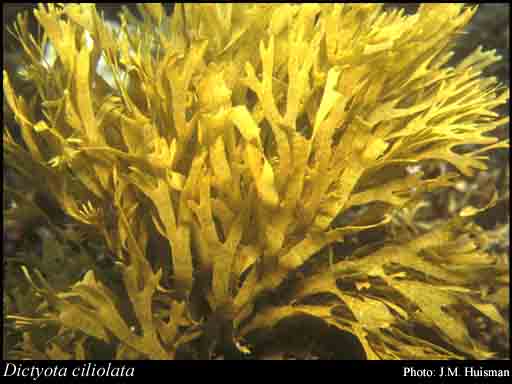- Reference
- Tab.Phycol. 9:12, Tab. 27, Fig. 1 (1859)
- Conservation Code
- Not threatened
- Naturalised Status
- Native to Western Australia
- Name Status
- Current

Scientific Description
Habit and structure. Thallus erect, to 25 cm tall, richly branched, medium brown. Axes dichotomous, variable in width, 2–12 mm wide, usually not tapering, 100–130 µm thick; distal dichotomies widening to form triangular terminal segments and acute divergence angles between the upper thallus branches. Margins usually dentate, but occasional specimens with smooth margins; apices rounded. Medulla monostromatic, of large hyaline cells, in T.S. 60–80 µm tall, 70–100 µm broad; cortex monostromatic, with smaller pigmented cells, in T.S. squarish but often slightly domed, 15–20 µm tall, in surface view 30–60 µm long. Surface cells often subdividing and forming hair tufts. Sporangia scattered across the thallus surface, solitary or in groups of 2 or 3 leaving a narrow sterile margin, spherical, 100–110 µm diam., with 1 stalk cell.
Distribution. Widely distributed in tropical and subtropical waters. Throughout northern W.A. and extending south to the Perth region.
Habitat. Generally epilithic in the intertidal and shallow subtidal.
[After Huisman & Phillips, Algae of Australia: Mar. Benthic Algae of North-western Australia, 1. Green and Brown Algae 201 (2015)]
Distribution
- IBRA Regions
- Carnarvon, Dampierland, Northern Kimberley, Pilbara, Swan Coastal Plain.
- IBRA Subregions
- Cape Range, Mitchell, Perth, Pindanland, Roebourne.
- IMCRA Regions
- Abrolhos Islands, Bonaparte Gulf, Canning, Central West Coast, Kimberley, Leeuwin-Naturaliste, Ningaloo, Pilbara (nearshore), Pilbara (offshore), Zuytdorp.
- Local Government Areas (LGAs)
- Ashburton, Broome, Cockburn, Cocos Islands, Derby-West Kimberley, Exmouth, Greater Geraldton, Irwin, Karratha, Port Hedland, Rockingham, Shark Bay, Stirling, Wyndham-East Kimberley.